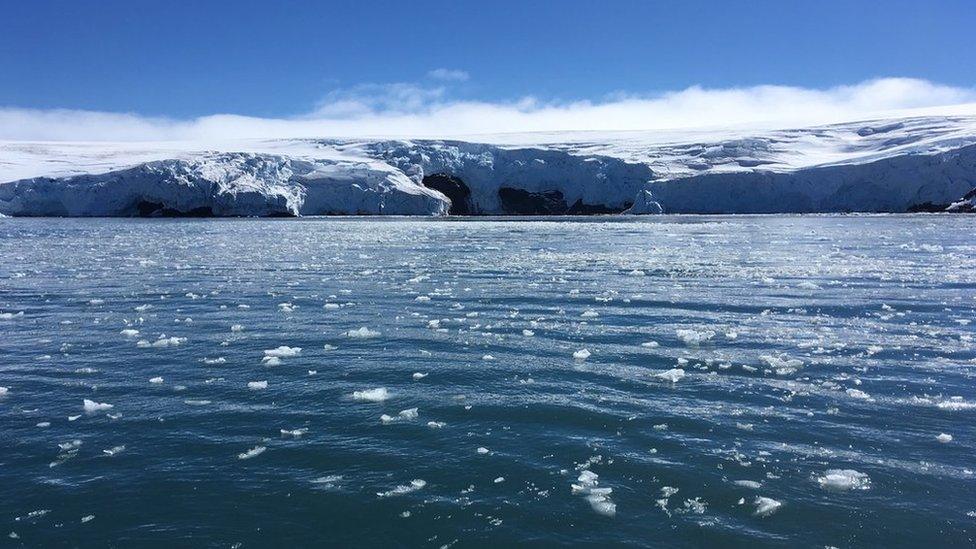Climate change: Methane gas leaking from Antarctica seabed
- Published
- comments

Methane has been discovered leaking from the seabed in Antarctica for the first time.
Scientists have also found that the bacteria that usually eats methane gas, to stop it rising up from the ocean, has not developed.
This could mean that the harmful gas is escaping into the Earth's atmosphere, which is concerning because methane contributes towards climate change.
Scientists believe that Antarctica contains as much as a quarter of the Earth's marine methane.
Signs of a methane seep are visible on the sea floor in Antarctica
The leak was first noticed in Antarctica's Ross Sea in 2011, but the team leading the study from the Oregon State University in the US had to wait until 2016 to carry out further research.
Marine Scientist Andrew Thurber told Newsround that although this leak is small it is telling the team a great deal about other potentially bigger seeps.
"Methane is efficient at warming our atmosphere and there are vast parts stored in the ice in Antarctica,"
"If methane escapes from the ocean, it is 25 times more dangerous than C02 to the atmosphere." Said Thurber.
What is the greenhouse gas effect?
The greenhouse effect is the name given to the natural process that causes the Earth to be warmer than it would be in the absence of an atmosphere. Greenhouse gases, like methane, are produced naturally and trap heat in the Earth's atmosphere, like a blanket.
Global warming is attributed to the enhanced greenhouse effect. This is caused by the increased concentration and effect of greenhouse gases, such as carbon dioxide, methane and fluorocarbons.
Why is climate change a problem?
He added: "This is the part of the globe that we shouldn't expect to seeing global warming, but it's a part that will be experiencing it in the future,
"Whenever we go to a site it's exciting, as a scientist, to explore a natural laboratory, but as human it's always worrying to discover something that we didn't expect to see - a greenhouse gas being omitted."
This is not the first time methane has been found leaking from the seabed, researchers have also seen it happening below the surface of the Arctic Ocean too.
Antarctica is absolutely enormous - about 58 times the size of the UK and covering almost 14 million square kilometres
How is methane trapped and how does it escape?
Methane can be stored under the seabed or within crystals of ice, known as methane hydrates.
It is usually caused by organic matter, like dead algae and animals or their poo, decomposing and sinking.
Environmental scientist Robert Sparkes, from Manchester Metropolitan University commented on the new findings, telling Newsround that there could be "hundreds of millions of tonnes of gas in the area".
"The prediction is that if the sea floor starts to warm, then the methane will escape. The ice crystals are stable when it's cold and there's high pressure, but if the sea warms up the methane won't be held in the crystals." Said Sparkes.
Andrew Thurber and his team were the last people to dive at the site
Although methane hydrates are present north of where the study was carried out, scientists do not yet know the source of the leak and that area of sea is yet to warm.
But other waters in Antarctica are 'drastically' warmer and the concerns about more methane being released are growing.
What is it like to live and carry out research in Antarctica? (July 2018)
What next?
Antarctica's hostile environment makes it a challenging place to explore and carry out research.
It is one of the coldest, driest and windiest places on the planet, the ice is almost 5km deep in some areas and wind speeds can reach more than 200 miles an hour there.
But finding out if there are other leaks and how bacteria are responding is a priority.
"We will continue to try to find how quickly the microbes eat the methane, and it's an exciting opportunity to understand this process, especially in Antarctica where we know so little." said Thurber.
The research has been published in the journal Proceedings of Royal Society B.
- Published23 September 2019
- Published21 July 2020
- Published2 January 2020
